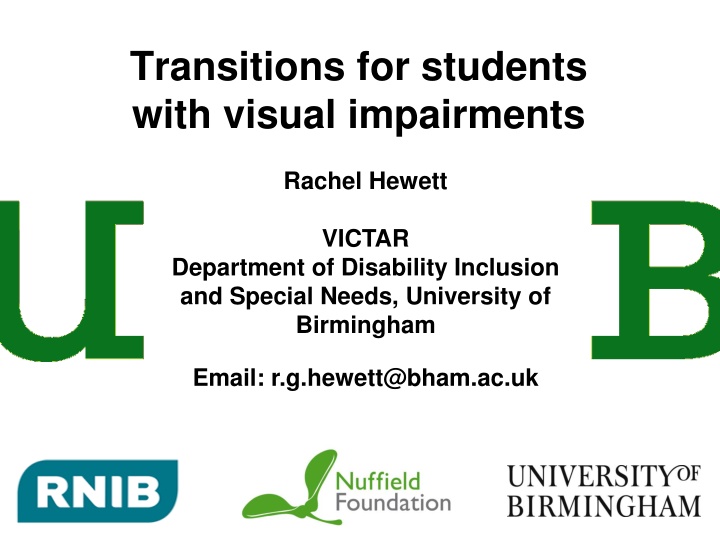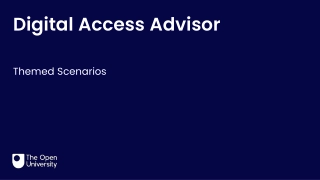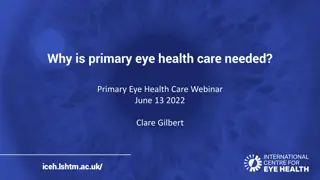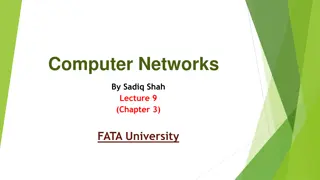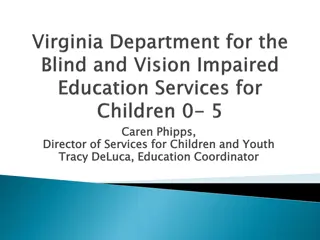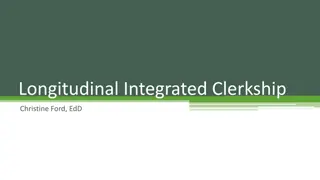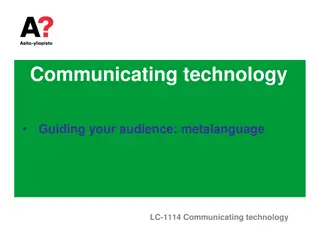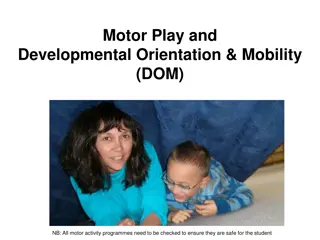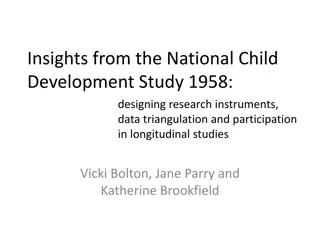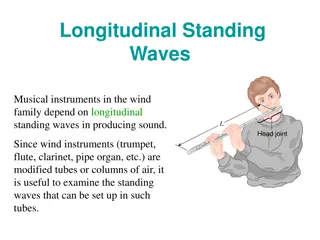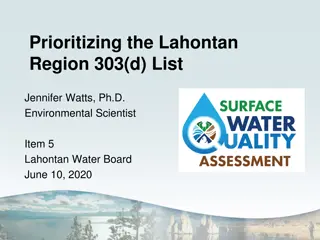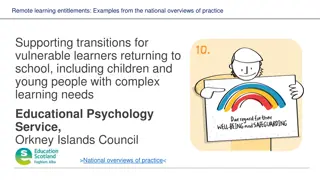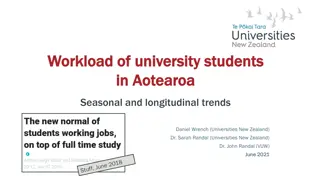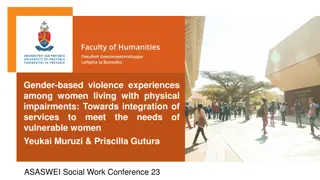Longitudinal Study on Transitions for Students with Visual Impairments
This presentation delves into the longitudinal study focusing on transitions for students with visual impairments conducted by VICTAR at the University of Birmingham. Covering aspects such as equipping young individuals with visual impairments to access information independently and their experiences transitioning into higher education, the project sheds light on the challenges and implications for practitioners in supporting these students effectively. With a strong emphasis on research findings and the unique concerns surrounding the employment and educational outcomes for visually impaired youth, the study aims to make a positive impact by tracking the experiences of over 80 participants over a five-year period.
Download Presentation

Please find below an Image/Link to download the presentation.
The content on the website is provided AS IS for your information and personal use only. It may not be sold, licensed, or shared on other websites without obtaining consent from the author.If you encounter any issues during the download, it is possible that the publisher has removed the file from their server.
You are allowed to download the files provided on this website for personal or commercial use, subject to the condition that they are used lawfully. All files are the property of their respective owners.
The content on the website is provided AS IS for your information and personal use only. It may not be sold, licensed, or shared on other websites without obtaining consent from the author.
E N D
Presentation Transcript
Transitions for students with visual impairments Rachel Hewett VICTAR Department of Disability Inclusion and Special Needs, University of Birmingham Email: r.g.hewett@bham.ac.uk
Visual Impairment Centre for Teaching and Research (VICTAR) The aims of VICTAR are to: Undertake social and educational research in the area of visual impairment Offer training in the area of visual impairment and education through high quality and relevant professional development programmes Disseminate our work to ensure it has positive impact
Overview of presentation Background to the Longitudinal Transitions Study Paper 1: Equipping young people with visual impairments to be able to independently access information Paper 2: Experiences of young people with visual impairments transitioning into higher education Implications for practitioners and future plans
Background to the project Five-year longitudinal study Phase one funded by RNIB Phase two funded by Nuffield Foundation Tracking the experience of over 80 young people with visual impairment (i.e. young people with low vision or blindness) through post-14 transition
Background to the project Concerns relating to the transition experience of young people with visual impairments Research findings show that the employment rate of people with visual impairments in the UK is very low Recent secondary data analysis of the UK labour force survey suggests that 44.4% of 16-25 year olds with visual impairment are not in education, employment or training (NEET)
Background to the project 82 participants recruited through local authority sensory support services. At the time they were aged 13-16. Now they are aged 17-20. We have collected data on their experiences twice a year Themes explored include: details of their visual impairment; educational experiences; access to exams; accessing information; use of technology; independence skills; self-advocacy skills; disability related benefits
Participants Characteristic Total (N) Total (%) Gender Male Female 37 45 45% 55% Preferred reading format Normal to large print (pt 12-17) Large print (pt 18-27) Very large print (pt 28+) Braille 37 45% 27 4 14 33% 5% 17% Type of school at time of recruitment Mainstream/mainstream school with attached resource base Special school 66 80% 16 20%
Participants Characteristic Total (N) Total (%) Registration type Blind Partially Sighted Registered but category unknown Not registered Participant does not know registration status Information not available 21 23 1 26% 28% 1% 11 8 13% 10% 18 22%
Participants Characteristic Additional Special Needs Total (N) 13 Total (%) 16% Yes No Unknown 58 11 71% 13% Statement of Special Educational Needs Yes 54 66% No Unknown 18 10 22% 12% Cohort recruited into Year 9 Year 10 Year 11 30 6 46 37% 7% 56%
Where are our participants now? (Autumn 2013, after 3.5 years in study) Setting Continuing in Further Education University Employment Apprenticeships NEET Other Total (N) Total (N) 28 Total (%) 44% 22 6 2 2 4 64 34% 9% 3% 3% 6% 100%
Paper 1: Equipping young people with visual impairments to be able to independently access information Taken from data collected in Autumn 2014 interviews (N=64). Research questions: 1. How young people with visual impairments access written information? 2. What specialist/non-specialist training have young people with visual impairments received to help them access information? 3. How well prepared are young people with visual impairments to access information once they leave compulsory education?
Paper 1: Accessing print and low vision aids Over 80% of the participants able to access print, some relying on point 18 or above. N=17 reported that they would get eyestrain if read for too long a period (30-60 minutes) Just over half the participants had used low vision aids, but many saw them negatively, and spoke of difficulties in using them Very few attended low vision clinics to have the opportunity to see the range of equipment available, and in some cases were given low vision aids from an unqualified person
Paper 1: Accessing braille N=20 participants taught to use braille More favourable outcomes for those who were taught braille at a very young age Specific circumstances where participants would favour braille over electronic material Many of the participants valued braille very highly
Paper 1: Accessing electronic material and specialist software Movement by the young people away from using specialist software towards making adjustment adjustments to mainstream equipment Participants making use of mainstream devices which have inbuilt accessibility options Many of the young people have discounted specialist software as they have found other ways to adapt. Question of whether these skills will be sufficient when in the workplace
Paper 1: A repertoire of ways to access information In the workplace, a sighted employee will access information in a variety of ways Necessity for people with visual impairments to be able to do likewise Two case studies
Paper 1: A repertoire of ways to access information Case Study 1 Been registered blind since birth. First started to learn braille at nursery, and was able to read grade one braille by primary school. She now regularly uses refreshable braille at college, and when reading large portions of text like books. She received touch typing lessons and training in speech software early on at mainstream school, and felt confident to use it in lessons once aged 7. She described herself as very confident in using specialist accessibility software, and attributes it to learning the skills at such a young age.
Paper 1: A repertoire of ways to access information Case Study 2 Recently been advised to change her registration from partially sighted to blind . Her primary way of accessing information is print with low vision aids (pt 36, or pt 48-72 without. Accesses a computer using magnification software. Previously used Supernova, which also has a screen reader, but switched to Zoomtext following advice. When trying to access print, it makes her eyes very tired, can only read for short periods of time. Had some braille tuition for three years, but did not progress beyond grade 1. Expected that her eye condition will continue to deteriorate, and in time she will no longer be able to able to read print at all.
Paper 1: A repertoire of ways to access information Case Study one young person is armed with a variety of skills which she can take into the workplace Case study two young person is likely to soon be in a position where she cannot access information at all
Paper 1: Conclusions Movement away from specialist equipment encouraging that mainstream technology is becoming more accessible. Question of whether will this be sufficient when in the workplace. Important that the young people have a range of methods for accessing information Thinking beyond what skills are needed to access the curriculum
Paper 2: Experiences of young people with visual impairments transitioning into higher education Interviews with 28 students who have or were looking to make the transition to university Focused work with 6 of these participants Given an opportunity to speak with participants in greater depth, including shadowing them on a typical day at university and speaking to key people around them
Background to the project why focus on those at university? 40% of young people in the UK entered higher education by the age of 19 Secondary data analysis indicates a positive impact of obtaining higher qualifications for people with visual impairments when seeking employment (above that of the general population) Some limited research/anecdotal evidence indicating difficulties for visually impaired students in UK higher education
Overview of participants currently at university (N=28) 10 previously attended specialist schools for students with visual impairment / 18 attended mainstream schools 9 students registered blind / 7 students registered partially sighted, others not registered Taking a variety of courses ranging from more traditional (English; Politics) to more vocational subjects (Environmental Management) Living arrangements all but four students have moved away from home for university
Overview of support at universities Model based upon: individual model of disability (equipment, learning support) social model of disability ((anticipatory) accommodations) UK-based students able to apply for Disabled Students Allowance DSA funds support provision such as note-takers, practical assistants, mobility training and specialist equipment Support and access arrangements coordinated by central disability support offices
Early Findings Enablers Indicators of a successful transition Barriers Barriers that may be faced by the young person outside of their control
Early findings indicators of a successful transition Early preparation Applying for disabled student allowance at earliest opportunity Researching in advance for disabled student allowance assessments know what you want Negotiating support agreements in good time allow time for arrangements to be put in place
Early findings indicators of a successful transition Self advocacy skills Able to explain to others how they want to work and the challenges they could face Able to communicate with staff if they experience problems Confidence to challenge where necessary
Early findings indicators of a successful transition Independence skills Mobility skills IT skills and able to independently access information Independent living skills
Early findings indicators of a successful transition Independence skills Mobility skills IT skills and able to independently access information Independent living skills
Barriers faced Compromising on support allocation once reached DSA funding limits Unable to have all required equipment Will only fund specialist equipment Necessity of young person to take lead Explaining disability to DSA assessors, disability support officers and lecturers
Barriers faced Complexity of number of people involved DSA, disability support officers, external agencies, lecturers, exams offices, transcription department, etc Lack of forward planning at university level Support not in place in time
Conclusions Current system is very reliant on the young person Need for better training of disability support officers and disabled student allowance assessors Can be a very overwhelming time for the young person
Conclusions UK Government wants to eventually change the support system with more focus on the university making adjustments Movement towards inclusion, but are universities currently equipped to do this? Emphasises the importance of the additional curriculum / expanded core curriculum
Implications for Practitioners and Future Work Child s age / developmental level (Time) Providing Access to Learning Teaching Learning to Access Increased independence; Emphasis upon additional curriculum
NCSE Report: Measuring Educational Engagement, Progress and Outcomes for Children with SEN Review which came from Councils ambition to explore how best to measure and assess how children with SEN are doing in the educational system, in order to ensure that the system is adequately serving their needs Approach included: International literature and policy review; case studies of different countries; analysis of Irish policy and practice
NCSE Report: Measuring Educational Engagement, Progress and Outcomes for Children with SEN Review revealed that educational outcomes in relation to children and young people with SEN are usefully grouped into: Attainment related outcomes Attendance related outcomes Happiness related outcomes Independence related outcomes Call for inclusive assessments which monitor additional curriculum matters of importance to those with special educational needs. e.g. mobility
Future work Tracking these young people as they continue with their courses, and look to make the transition into graduate positions. Particularly looking at their experiences within the labour market. Developing practical resources based on our research findings which can be used by both young people with visual impairments, and those involved in supporting them
Further information Email Rachel Hewett: r.g.hewett@bham.ac.uk Project website: http://www.birmingham.ac.uk/research/activity/educatio n/projects/transitions-study.aspx VICTAR website http://www.birmingham.ac.uk/research/activity/e ducation/victar/index.aspx
Acknowledgements Project team Graeme Douglas, PI Sue Keil, RNIB Funders Royal National Institute of Blind People Nuffield Foundation
